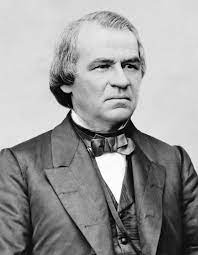Radical Reconstruction EOTO
Radical reconstruction is a period in United States History that took place after the American Civil War ended in 1865. After the Union defeated the confederacy the two sides worked together to restore the nation from 1865 to 1867 in a period called reconstruction.
During Reconstruction, there were disagreements about how exactly the United States was going to accomplish this goal of reconstruction. Specifically, there were disagreements about how the southern states were going to be readmitted back into the unions and about African American rights after they were freed from slavery. During the Civil War, however, Lincoln had made a plan to quickly readmit the confederate states after the war, but after he was assassinated in 1865, Andrew Johnson became the president and Lincoln's plan was not followed.
A group of people called radical republicans disagreed with the way President Andrew Johnson was handling reconstruction. They believed that the southern states should be punished and that African Americans should be protected. Then two years after Andrew Johnson became president in 1867 these radical republicans took control of congress resulting in the period known as Radical Reconstruction.
During the period of Radical Reconstruction, the south was put under military rule and most of its leaders were removed from office. This allowed African Americans and white people who sided with the union to be in control of the southern states.
This obviously caused a lot of criticism from the southerners. They criticized northerners that came down to the south and called them carpetbaggers. This term was used as an insult to someone who came down to the south from the north with only their belongings that they could fit into a small bag. This was piggybacked with another accusation that the northerners were taking advantage of the situation by sending all of these people down. Although there was a lot of pushback from the southerners, some people did comply with northern interests. Of course, the people who did comply with the union were also criticized. Some southerners accused them of only complying with the north for their own personal interests and advancements; these people were nicknamed scalawags. It is clear that there was a lot of stigma surrounding the union in the south because of the recent war.
Congress also required southern states to ratify the 14th amendment to the constitution before they were allowed to rejoin the union. The 14th amendment granted citizenship to African Americans. By 1870 all 11 former confederate states had rejoined the union; also in 1870 the 15th amendment guaranteed African Americans with the right to vote. Following this voters elected African Americans into office positions, and also into congress.
Radical reconstruction gradually came to an end for many reasons. First, some republican leaders died. People also started accusing the government of dishonesty. The Ku Klux Klan also rose to relevance in the south and terrorized black American citizens. Terrorist groups like these worked to socially revoke voting rights from African Americans and tried to prevent them from running for office. As a result of these factors, southern democrats who were in support of the confederacy took back control of the south.
The last major event of radical reconstruction was the election of 1867. The election was extremely close both republicans and democrats were claiming victories. Rutherford B Hayes decided to make a compromise between the democrats and republicans or the north and the south and declared that he as president would remove the army troops from the south. So, in 1877 after Hayes took office the troops were removed from the south leaving the southern democrats in complete control of the south once again ending the period of radical reconstruction.
Overall I think that the period of radical reconstruction escalated as a result of the stigma that surrounded the war. The south was resentful towards the north and the north was resentful towards the south. This created the period of reconstruction difficult because of the difference in interests and opinions. At this time in American History, the country was at its lowest after an internal war fought over a difference in morals, the assignation of its leader, and the disagreements in African American standings in American society.








Comments
Post a Comment